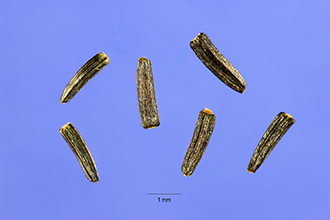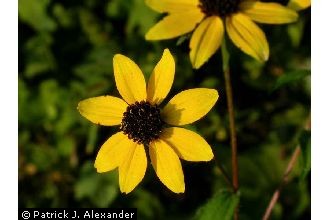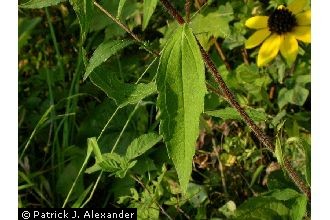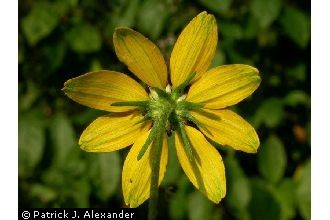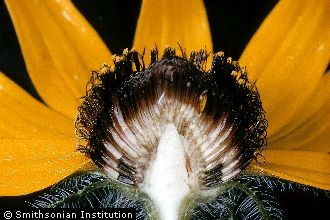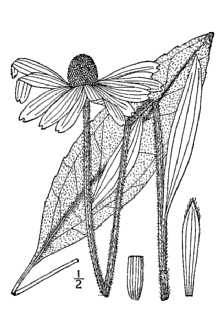Blackeyed Susan
Scientific Name: Rudbeckia hirta L.
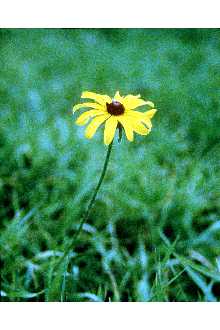
| General Information | |
|---|---|
| Usda Symbol | RUHI2 |
| Group | Dicot |
| Life Cycle | AnnualBiennial, Perennial, |
| Growth Habits | Forb/herb |
| Native Locations | RUHI2 |
Plant Guide
Description
General: Black-eyed Susan is a native, warm season forb in the Asteraceae family (Fig.1). Black-eyed Susan may be annual, biennial, or a short-lived perennial. The plant grows from a taproot which produces many stiff, coarse, upright pubescent stems 1 to 3 feet (0.3 to 0.9 m) tall (Tyrl et al., 2008). The alternately arranged basal leaves are up to 3 inches (7.5 cm) wide and 4 inches (10 cm) long and have either entire or slightly toothed margins. Each stem produces a solitary bloom up to 2.5 inches (6 cm) in diameter with eight to twenty yellow ray flowers around a flattish cone like structure (Ajilvsi, 2003). Black-eyed Susan blooms from summer through early fall (Ladybird Johnson Wildflower Center, 2019). The seeds or achenes are four sided, elliptical shaped, less than 5/64 inch (2 mm) long with no appendages or pappus (Tyrl et al., 2008). Distribution: The Rudbeckia genus contains approximately 23 species in North America. Rudbeckia hirta is found throughout the United States (USDA NRCS, 2019). Within Rudbeckia hirta, there are four botanical varieties. Rudbeckia hirta var. floridana is found in Florida. Rudbeckia hirta var. angustifolia occurs in Texas and the southeastern US to North Carolina. Rudbeckia hirta var. hirta occurs in the eastern half of the US. Rudbeckia hirta var. pulcherrina is most widespread and found in all the continental US except Nevada and Arizona (USDA NRCS, 2019). For current distribution, please consult the Plant Profile page for this species on the PLANTS Web site. Habitat: Black-eyed Susan is found in fields, pastures, prairies, open woodlands, along railroad tracks, roadsides, and abandoned areas (Ajilvsgi, 2003; Illinois Wildflowers, 2019). Associated plants include leadplant (Amorpha canescens), sawtooth sunflower (Helianthus grosseserratus), stiff sunflower (Helianthus rigidus), rattlesnake master (Eryngium yuccifolium), eastern red cedar (Juniperus virginiana), dewberry (Rubus sp.), chokecherry (Prunus virginiana), and flowering spurge (Euphorbia corollate) in tall grass prairie sites in Missouri and Illinois (Hurd and Christensen, 1975; Johnson and Anderson, 1986).
Adaptation
Black-eyed Susan is an early successional species adapted to clay, loam, and sandy soils (Tyrl et al., 2008). This forb prefers acidic soils less than 6.8 pH and grows well in full sun with slightly moist to moderately dry soil conditions (Ladybird Johnson Wildflower Center, 2019; Illinois Wildflowers, 2019).
Uses
Black-eyed Susan has poor to fair value for livestock (Tyrl et al., 2008). Dyksterhuis (1948) reported cattle grazed black- eyed Susan lightly in late April, heavily in May, and lightly in June, but was not grazed any other time. Natural Resources Conservation Service Plant Guide Figure 1. Black-eyed Susan in bloom. Photo credit: Larry Allain, US Geological Survey. 2 Wildlife and pollinator insects use black-eyed Susan. White-tailed deer (Odocoileus virginianus) graze on the basal leaves in winter (Miller and Miller, 1999). Little Carpenter bees (Ceratina sp.), Leaf Cutting bees (Megachile sp.), and Green Metallic bees (Agapostemon sp.) collect pollen and nectar (Fig.2). Coneflower Miner bees (Andrena rudbeckiae) prefer Rudbeckia flowers (Illinois Wildflowers, 2019). Black-eyed Susan is a larval host for Silvery Checkerspot (Chlosyne nycteis) and Bordered Patch (Chlosyne lacinia) butterfly caterpillars and adult butterflies are attracted to the plant (Ladybird Johnson Wildflower Center, 2019). Bobwhite quail (Colinus sp.), wild turkey (Meleagris gallopavo), and songbirds eat its seeds (Tyrl et al., 2008).
Ethnobotany
Native American Indian tribes utilized the entire black-eyed Susan plant. Yellow and green dyes were produced from the blooms (Ajilvsi, 2003). Derivatives from roots, stems, leaves, and florets were used to treat various ailments (Tyrl et al., 2008). The Cherokee prepared a leaf wash to heal swelling caused by worms. Sores were bathed with root infusions and earaches treated with root oozes. The Iroquois used root infusions to treat children with worms and a root decoction for heart medicine. The Potawatomi treated colds with root infusions (Moerman, 2015).
Status
Threatened or Endangered: Rudbeckia hirta is not threatened or endangered (US Fish and Wildlife Service, 2019). Wetland Indicator: Rudbeckia hirta is a facultative upland (FACU) plant in the Northcentral and Northeast, Eastern Mountains and Piedmont, Atlantic and Gulf Coastal Plain, Midwest, Great Plains, Arid West, and Western Mountains, Valleys, and Coast regions of the United States. Facultative upland plants usually occur in non-wetlands but may also occur in wetlands (US Army Corps of Engineers, 2018). Weedy or Invasive: This plant may become weedy or invasive in some regions or habitats and may displace desirable vegetation if not effectively managed. Please consult with your local NRCS Field Office, Cooperative Extension Service office, state natural resource, or state agriculture department regarding its status and use. Please consult the PLANTS Web site (http://plants.usda.gov/) and your state’s Department of Natural Resources for this plant’s current status (e.g., threatened or endangered species, state noxious status, and wetland indicator values).
Planting Guidelines
Plant black-eyed Susan is planted with a no-till drill, conventional drill equipped with a small seed or wildflower seed box, or broadcast seeding. Prepare a weed free seedbed using light tillage, herbicide applications for conventional and broadcast planting. Lightly disk or harrow to loosen the soil surface then roll or cultipack prior to seeding. A firm seedbed is needed as seedling emergence is poor in a fluffy seedbed (Grabowski, 2001). Use a seeding rate of 0.8 pure live seed (PLS) lb/acre when drill planting on 20 inch or less row spacing; 0.7 PLS lb/acre when drill planting on 21 to 40 inch row spacing; and 1 PLS lb/acre when broadcast seeding. Seed black-eyed Susan in mid-September through April (USDA NRCS, 2018). Place the seed ¼ inch (6mm) deep and leave the drill planter furrows open (Grabowski, 2001). Seed should be placed close to the soil surface then rolled or cultipacked after broadcast seeding to ensure good seed-to-soil contact.
Management
Clip wilted blooms of black-eyed Susan to promote blooming and/or reduce self-seeding (Missouri Botanical Garden, 2019). Black-eyed Susan eventually declines without soil disturbance. Disk the site every two to three years to control perennial weeds and promote black-eyed Susan germination (Burgess et al., 2010). Black-eyed Susan increased on pastures in fair or poor condition but was not observed in pastures in good or excellent condition (Dyksterhuis, 1948). Therefore, monitoring grazing and improving pasture condition are ways to control black-eyed Susan.
Pests and Potential Problems
Pests include aphids (Aphididae sp.) which suck plant sap and produce a sticky honeydew. Diseases include downy mildew (Sclerospora sp.) which attacks seedlings and produces light yellow spots on foliage, powdery mildew (Erysiphe sp.) that Figure 2. Black-eyed Susan is a pollen and nectar source for bees and butterflies. Figure 3. A butterfly draws nectar from a black-eyed Susan bloom.
Environmental Concerns
Concerns , Use soil moisture sensors to measure the soil moisture of Blackeyed Susan.
Concerns
Black-eyed Susan is considered a desirable plant within its native range and has no known detrimental effects on the environment.
Control
Black-eyed Susan can be controlled by mechanical means such as mowing or applying a broad-spectrum herbicide. Please contact your local agricultural extension specialist or county weed specialist to learn what works best in your area and how to use it safely. Always read label and safety instructions for each control method. Control measures appear in this document only to provide specific information.
Seeds and Plant Production
Plant Production
Plant Production
Prepare a weed free seedbed using tillage and/or herbicide application. Prior to planting, the seedbed must be firmed and accumulated moisture for improved establishment success. Direct sow using a no-till drill, conventional drill with small seed or wildflower box, or broadcast seed. Refer to Planting Guidelines for appropriate seeding rate based on row spacing and seeding method, and plant in mid-September through April (USDA NRCS, 2018). When broadcast seeding, mix the seed with a carrier such as cat litter or coarse sand to improve seed distribution and help prevent planting at too high a rate. Roll or cultipack the planting site to ensure good seed-to-soil contact after planting. Black-eyed seedlings emerge in fall, overwinter as rosettes, and begin rapid spring growth. Apply 20-30 lb/acre N in the spring to aid plant growth and development. Avoid cultivating plants in rows as they do not tolerate root disturbance or soil deposited on them from the field cultivator (Grabowski, 2005). Sometimes fall planted seeds germinate the following spring. Spring germination causes the plants to flower sporadically and reduces seed harvest. If this occurs, leave the plants to mature, produce seed, and then mow to improve the stand. Harvest seed the following year (Grabowski, 2001). Harvest seed in mid-summer using a combine equipped with a slow speed fan. Black-eyed Susan ripens indeterminately; therefore, seed harvest should be completed when most of the seed heads are mature. Harvest seed soon after the seed heads are brown and woolly in appearance but before shattering (Figure 3). Air dry and scalp the harvested material. Use a seed cleaner with air adjustments and separation screens to remove chaff and unfilled seed. Recommended screen sizes are 1/16 or 1/18 round hole for top screens and 36 x 36 or 6 x 36 wire mesh screen for the bottom to remove fine material and sand (Grabowski, 2005). Cleaned seed (Fig. 4) yields range from 20 to 30 lb/acre at the USDA NRCS Jamie L. Whitten Plant Materials Center in Coffeeville, MS (MSPMC). Seed purity varied from 57% to 82% and seed germination ranged from 22% to 90%. Seeds remained viable up to five years in controlled storage conditions of 55°F and 45% relative humidity (Grabowski, 2001). Phillips (1985) mentions the seeds have no prolonged dormancy and Andersen (1968) notes they require no pretreatment for germination. Start black-eyed Susan transplants in the greenhouse. Direct sow into individual planting tray cells filled with sterile growing media. After sowing, cover the seeds with a thin layer of growing media and lightly water. Place the trays in a greenhouse set at 65°F-70°F daytime temperature and 55°F nighttime temperature (Butler and Frieswyk, 2001). Seed should germinate and emerge in approximately two weeks after planting. Thin to obtain one vigorous seedling. Keep growing media moist but not overwater because the plants are vulnerable to damping off or rot if overwatered (Phillips, 1985). Grow the transplants in the Figure 4. Signs of maturing Rudbeckia seed heads include dried ray flowers and a brown, woolly appearance. Figure 5. Rudbeckia hirta seeds are small and four sided. Photo credit: Steve Hurst, ARS Systematic Botany and Mycology Laboratory, hosted by the USDA-NRCS PLANTS Database. 4 greenhouse until they develop a firm, fibrous root plug. Then move the plant trays to a shade house and harden off for one to two weeks before transplanting outside. Cultivars, Improved, and Selected Materials (and area of origin) Black-eyed Susan seed and plants are available commercially. Cultivars should be selected based on local climate, resistance to local pests, and intended use. Consult with your local land grant university, local agricultural or horticultural extension agent, or local USDA NRCS office for recommendations on adapted cultivars for use in your area.
Literature Cited
Ajilvsgi, G. 2003. Wildflowers of Texas. Shearer Publishing. Fredericksburg, TX. Andersen, R. 1968. Germination and establishment of weeds for experimental purposes. Weed Science Society of America, W.F. Humphrey Press, Inc., Geneva, NY. 236 p. Burgess, L., T. Moss, J. Pomerlee, and J. Allison. 2010. Fact sheet-guidelines for fall wildflower planting. Jamie L. Whitten Plant Materials Center. Coffeeville, MS. Butler, J. and C. Frieswyk. 2001. Propagation protocol for production of propagules (seeds, cuttings, poles, etc.) Rudbeckia hirta seeds USDI NPS – Rocky Mountain National Park Estes Park, Colorado. In: Native Plant Network. Accessed online 3/25/2019 at: http://NativePlantNetwork.org US Department of Agriculture, Forest Service, National Center for Reforestation, Nurseries, and Genetic Resources. Dyksterhuis, E. 1948. The vegetation of the western cross timbers. Ecological Monographs. 18(3): pg. 326-376. Gilman, E. and T. Howe. 1999. Rudbeckia hirta black-eyed Susan, gloriosa daisy- Pub. FPS512. Univ. of Florida Extension. Univ. of Florida, Gainesville, FL. Grabowski, J. 2001. Propagation protocol for production of propagules (seeds, Cuttings, poles, etc.) Rudbeckia hirta L. plants USDA NRCS Coffeeville/Jamie L. Whitten Plant Materials Center, Coffeeville, Mississippi. In: Native Plant Network. Accessed online: 3/15/2019 at http://NativePlantNetwork.org US Department of Agriculture, Forest Service, National Center for Reforestation, Nurseries, and Genetic Resources. Grabowski, J. 2005. Native wildflower seed production techniques in Mississippi. Native Plants Journal. Univ. of Wisconsin Press. Vol 6(1): pg. 72-75. Hurd, R. and D. Christensen. 1975. Ecology study of friendly prairie, Missouri. In: Wali, M. ed. Prairie: a multiple view. Grand Forks, ND. Univ. of North Dakota Press. pg. 89-102. Illinois Wildflowers. 2019. Black-eyed Susan-Rudbeckia hirta. Accessed online 3/21/2019 at: https://www.illinoiswildflowers.info/prairie/plantx/be_susanx.htm Johnson, R. and R. Anderson. 1986. The seed bank of a tallgrass prairie in Illinois. American Midland Naturalist. Vol. 115(1): pg. 123-130. Ladybird Johnson Wildflower Center. 2019. Plant database – Rudbeckia hirta. Accessed online on 3/15/2019 at: https://www.wildflower.org/plants/result.php?id_plant=ruhi2 Ladybird Johnson Wildflower Center. Austin, TX. Miller, J. and K. Miller. 1999. Forest plants of the southeast and their wildlife uses. Southern Weed Science Society. Missouri Botanical Garden. 2019. Rudbeckia hirta. Accessed online: 3/15/2019 at http://www.missouribotanicalgarden.org/PlantFinder/PlantFinderDetails.aspx?taxonid=277225 Moerman, D. 2015. Native American medicinal plants-an ethnobotanical dictionary. 5th printing. Timber Press, Portland OR. Phillips, H. 1985. Growing and propagating wildflowers. Univ. of North Carolina Press, Chapel Hill, NC. 330 p. Tyrl, R., T. Bidwell, R. Masters, and R. Elmore. 2008. Field guide to Oklahoma plants-commonly encountered prairie, shrubland, and forest species. 2nd ed. Dept. of Natural Resource Ecology and Management. Oklahoma State Univ. Stillwater, OK.
Plant Traits
Growth Requirements
| CaCO3 Tolerance | None |
|---|---|
| Frost Free Days, Minimum | 165 |
| Frost Free Days, Minimum | 150 |
| Fire Tolerance | Medium |
| Fire Tolerance | Medium |
| Fertility Requirement | Medium |
| Fertility Requirement | Medium |
| Drought Tolerance | Medium |
| Drought Tolerance | Medium |
| Cold Stratification Required | No |
| Cold Stratification Required | No |
| Temperature, Minimum (°F) | -23 |
| CaCO3 Tolerance | None |
| Anaerobic Tolerance | None |
| Anaerobic Tolerance | None |
| Adapted to Medium Textured Soils | Yes |
| Adapted to Medium Textured Soils | Yes |
| Adapted to Fine Textured Soils | Yes |
| Adapted to Fine Textured Soils | Yes |
| Adapted to Coarse Textured Soils | No |
| Adapted to Coarse Textured Soils | No |
| Hedge Tolerance | None |
| Temperature, Minimum (°F) | -23 |
| Shade Tolerance | Intolerant |
| Shade Tolerance | Intolerant |
| Salinity Tolerance | None |
| Salinity Tolerance | None |
| Root Depth, Minimum (inches) | 10 |
| Root Depth, Minimum (inches) | 10 |
| Precipitation, Minimum | 32 |
| Precipitation, Minimum | 28 |
| Precipitation, Maximum | 65 |
| Precipitation, Maximum | 65 |
| pH, Minimum | 6.0 |
| pH, Minimum | 6.0 |
| pH, Maximum | 7.0 |
| pH, Maximum | 7.0 |
| Moisture Use | Medium |
| Moisture Use | Medium |
| Hedge Tolerance | None |
Morphology/Physiology
| Active Growth Period | Fall, Winter and Spring |
|---|---|
| Toxicity | None |
| Toxicity | None |
| Shape and Orientation | Semi-Erect |
| Shape and Orientation | Semi-Erect |
| Fire Resistant | No |
| Foliage Porosity Winter | Porous |
| Foliage Porosity Winter | Porous |
| Foliage Porosity Summer | Porous |
| Foliage Porosity Summer | Dense |
| Foliage Color | Green |
| Foliage Color | Green |
| Flower Conspicuous | Yes |
| Flower Conspicuous | Yes |
| Flower Color | Orange |
| Flower Color | Orange |
| Fire Resistant | No |
| Resprout Ability | No |
| Fall Conspicuous | No |
| Fall Conspicuous | No |
| Coppice Potential | No |
| Coppice Potential | No |
| C:N Ratio | Medium |
| C:N Ratio | Medium |
| Bloat | None |
| Bloat | None |
| Active Growth Period | Fall, Winter and Spring |
| Resprout Ability | No |
| Foliage Texture | Coarse |
| Nitrogen Fixation | None |
| Nitrogen Fixation | None |
| Low Growing Grass | No |
| Low Growing Grass | No |
| Lifespan | Short |
| Lifespan | Short |
| Leaf Retention | No |
| Leaf Retention | No |
| Known Allelopath | No |
| Known Allelopath | No |
| Height, Mature (feet) | 1.0 |
| Height, Mature (feet) | 1.0 |
| Foliage Texture | Coarse |
| Fruit/Seed Color | Brown |
| Fruit/Seed Color | Brown |
| Fruit/Seed Conspicuous | No |
| Fruit/Seed Conspicuous | No |
| Growth Form | Single Stem |
| Growth Form | Single Stem |
| Growth Rate | Rapid |
| Growth Rate | Rapid |
Reproduction
| Propagated by Cuttings | No |
|---|---|
| Propagated by Seed | Yes |
| Propagated by Seed | Yes |
| Propagated by Sod | No |
| Propagated by Sod | No |
| Propagated by Sprigs | No |
| Propagated by Sprigs | No |
| Propagated by Tubers | No |
| Propagated by Tubers | No |
| Fruit/Seed Persistence | No |
| Seed per Pound | 1575760 |
| Seed per Pound | 1575760 |
| Seed Spread Rate | Moderate |
| Seed Spread Rate | Moderate |
| Seedling Vigor | Medium |
| Seedling Vigor | Medium |
| Small Grain | No |
| Small Grain | No |
| Vegetative Spread Rate | None |
| Vegetative Spread Rate | None |
| Propagated by Corm | No |
| Propagated by Cuttings | No |
| Bloom Period | Mid Summer |
| Bloom Period | Summer |
| Commercial Availability | Routinely Available |
| Commercial Availability | Routinely Available |
| Fruit/Seed Abundance | High |
| Fruit/Seed Abundance | High |
| Fruit/Seed Period Begin | Summer |
| Fruit/Seed Period Begin | Summer |
| Fruit/Seed Period End | Summer |
| Fruit/Seed Persistence | No |
| Propagated by Bare Root | No |
| Propagated by Bare Root | No |
| Propagated by Bulb | No |
| Propagated by Bulb | No |
| Propagated by Container | No |
| Propagated by Container | No |
| Propagated by Corm | No |
| Fruit/Seed Period End | Summer |
Suitability/Use
| Palatable Browse Animal | Low |
|---|---|
| Palatable Graze Animal | Low |
| Palatable Graze Animal | Low |
| Palatable Human | No |
| Palatable Human | No |
| Post Product | No |
| Post Product | No |
| Protein Potential | Low |
| Protein Potential | Low |
| Pulpwood Product | No |
| Pulpwood Product | No |
| Veneer Product | No |
| Veneer Product | No |
| Palatable Browse Animal | Low |
| Nursery Stock Product | No |
| Nursery Stock Product | No |
| Naval Store Product | No |
| Naval Store Product | No |
| Lumber Product | No |
| Lumber Product | No |
| Fodder Product | No |
| Fodder Product | No |
| Christmas Tree Product | No |
| Christmas Tree Product | No |
| Berry/Nut/Seed Product | No |
| Berry/Nut/Seed Product | No |

